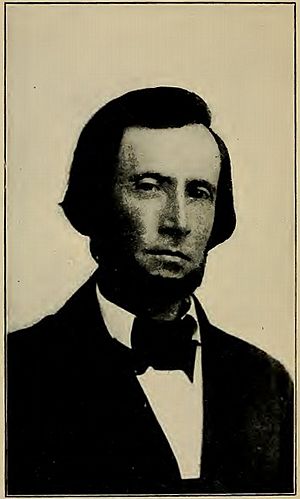Charles Frederick Fisher facts for kids
Quick facts for kids
Charles Frederick Fisher
|
|
|---|---|
 |
|
| Born | December 26, 1816 Salisbury, North Carolina |
| Died | July 21, 1861 (aged 44) Manassas, Virginia |
| Buried |
Old Lutheran Church Cemetery
Salisbury, North Carolina |
| Allegiance | |
| Service/ |
|
| Years of service | 1861–61 |
| Rank | |
| Commands held | |
| Battles/wars | American Civil War |
| Spouse(s) | Elizabeth Caldwell |
Charles Frederick Fisher (born December 26, 1816 – died July 21, 1861) was an important person from Salisbury, North Carolina. He was a lawyer, a lawmaker, an engineer, and a soldier. He led the North Carolina Railroad as its president. Fisher died while fighting in the American Civil War, leading a group of soldiers from North Carolina.
Early Life and Family
Charles Frederick Fisher was born in Salisbury in 1816. His parents were Christine Beard Fisher and Charles Fisher. His father was a lawmaker and owned a large farm. Charles's grandfather, Frederick Fisher, moved to North Carolina from Virginia. He was an officer in the local army during the American Revolutionary War.
Charles went to Yale University in 1835, but he did not finish his first year. He married Ruth Caldwell. Her father, David Caldwell, was a businessman and lawmaker. Charles and Ruth had three children. After Charles died, relatives raised his children. Their oldest daughter, Christine, became a famous author.
His Career
Even though Charles Fisher did not finish college, he became a farmer, a miner, and a journalist. His father was a politician for 28 years. Charles helped him by co-publishing a newspaper called the Western Carolinian.
Fisher was a member of the Democratic Party. He won his first political job in 1854. Voters in Rowan County chose him to be a state senator.
The next year, Fisher became the president of the North Carolina Railroad. He took over from a former governor, John Motley Morehead. While he was still the railroad's president, he also got the job to build a new train line to Morganton, North Carolina.
Building the new line was slow and cost a lot of money. This led to some criticism, especially from Jonathan Worth. Worth was a businessman and lawyer who led a competing road company. Even with the criticism, the railroad's owners chose Fisher to be president again in 1859. Fisher also became good friends with Sewall Lawrence Fremont. Fremont was an engineer for another railroad in North Carolina.
Role in the Civil War
When the American Civil War began, both Charles Fisher and his friend Sewall Fremont joined the Confederate States Army. Fisher became a Colonel, which is a high-ranking officer. He was in charge of the 6th North Carolina Infantry Regiment.
Colonel Fisher died leading his soldiers in a battle. This happened at the First Battle of Bull Run. He was trying to capture a cannon position held by the Union Army. It is not known exactly who fired the shot that killed him.
Remembering Charles Fisher
Charles Fisher was buried in the Old Lutheran Cemetery in Salisbury. After his death, many people saw him as an early hero of the Confederacy. His soldiers put up a marker where he fell, but it was later damaged. A flagpole now stands in its place.
His friend, S.L. Fremont, later became a commander of North Carolina's coastal defenses. He named Fort Fisher after Charles to honor his bravery. This fort was at the mouth of the Cape Fear River. Later, groups like the United Confederate Veterans and the United Daughters of the Confederacy also placed markers to remember him. Charles Fisher's hat is now kept at the North Carolina Museum of History.

